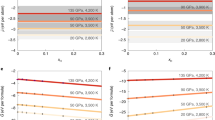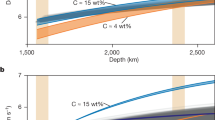Abstract
IN a recent communication, Strong1 gave the results of an experimental determination of the fusion curve of iron up to a pressure of 96,000 atmospheres. On the usual assumption that the Earth's core is composed of iron, he extrapolated his results to obtain a value of 2,610 ± 200° K. for the melting point in the core at the core–mantle boundary. His experimental results fitted Simon's2 equation:  with the constants a = 75,000 atmospheres and c = 8. In this equation p is the pressure in atmospheres, T
0 the melting temperature in degrees Kelvin at one atmosphere (that is, T
0 = 1,805° K.), and T
m the melting temperature at the pressure p. Estimates of the melting point in the Earth's core obtained by Strong are appreciably lower than those obtained using Simon's values for the constants a and c, and only about one-half of those obtained using Gilvarry's3 more recent values. Moreover, the gradient of the melting point curve is much lower than in these previous estimates. The value of 2,610° K. for the melting point at the core–mantle boundary is particularly interesting in view of Verhoogen's4 conclusion that the temperature there is not likely to exceed 2,700° K. and his previous estimate5 of 2,500° C. as the maximum, which was based on the hypothesis that the maximum observed surface temperature of lavas reflects the maximum temperature in the mantle. Since seismic evidence indicates that the outer core in any event is liquid, these two results of Strong and Verhoogen taken together fix the temperature T
1 at the core–mantle boundary rather precisely, namely:
with the constants a = 75,000 atmospheres and c = 8. In this equation p is the pressure in atmospheres, T
0 the melting temperature in degrees Kelvin at one atmosphere (that is, T
0 = 1,805° K.), and T
m the melting temperature at the pressure p. Estimates of the melting point in the Earth's core obtained by Strong are appreciably lower than those obtained using Simon's values for the constants a and c, and only about one-half of those obtained using Gilvarry's3 more recent values. Moreover, the gradient of the melting point curve is much lower than in these previous estimates. The value of 2,610° K. for the melting point at the core–mantle boundary is particularly interesting in view of Verhoogen's4 conclusion that the temperature there is not likely to exceed 2,700° K. and his previous estimate5 of 2,500° C. as the maximum, which was based on the hypothesis that the maximum observed surface temperature of lavas reflects the maximum temperature in the mantle. Since seismic evidence indicates that the outer core in any event is liquid, these two results of Strong and Verhoogen taken together fix the temperature T
1 at the core–mantle boundary rather precisely, namely:  so that a value of 2,650° K. for T1 seems reasonable.
so that a value of 2,650° K. for T1 seems reasonable.
This is a preview of subscription content, access via your institution
Access options
Subscribe to this journal
Receive 51 print issues and online access
$199.00 per year
only $3.90 per issue
Buy this article
- Purchase on Springer Link
- Instant access to full article PDF
Prices may be subject to local taxes which are calculated during checkout
Similar content being viewed by others
References
Strong, H. M., Nature, 183, 1381 (1959).
Simon, F. E., Nature, 172, 746 (1953).
Gilvarry, J. J., Nature, 178, 1249 (1956); J. Atmos. and Terr. Phys., 10, 84 (1957).
Verhoogen, J., Trans. Amer. Geophys. Union, 36, 866 (1955).
Verhoogen, J., Trans. Amer. Geophys. Union, 35, 85 (1954).
Uffen, R. J., Trans. Amer. Geophys. Union, 33, 893 (1952).
Jacobs, J. A., Nature, 172, 297 (1953).
Vallé, P. E., Annali di Geofisica, 5, 41 (1952).
Jacobs, J. A., Can. J. Phys., 31, 370 (1953).
Author information
Authors and Affiliations
Rights and permissions
About this article
Cite this article
JACOBS, J. Temperatures within the Earth's Core. Nature 185, 521–522 (1960). https://doi.org/10.1038/185521a0
Issue Date:
DOI: https://doi.org/10.1038/185521a0
Comments
By submitting a comment you agree to abide by our Terms and Community Guidelines. If you find something abusive or that does not comply with our terms or guidelines please flag it as inappropriate.



